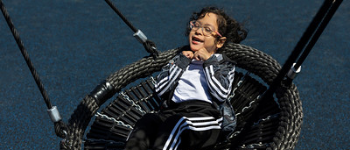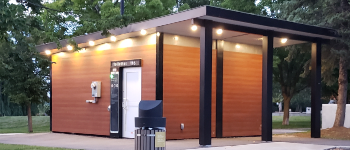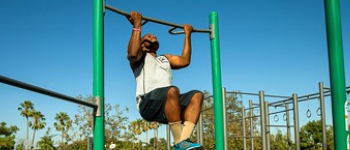The Importance of Safe Play and How To Build a Safe Playground
Nov 08







Jan 26
A playground is a fun and exciting place for children to play and explore. However, the design and construction of playgrounds involves a lot of specialized terms that may seem unfamiliar to those who are not experts in the field.
If you're interested in building a playground in your community, it's important to know the meaning of these terms so that you can make informed decisions about what equipment and features to include. In this blog post, we'll provide definitions for some of the most important playground terms that you should know!
A playground is a designated area thoughtfully-designed and built for children to play, engage in active physical activity, and develop critical social and cognitive skills. They include a wide range of equipment, such as swings, slides, monkey bars, climbing structures, safety surfacing, and other site amenities. You can find them in various settings, such as parks, schools, places of worship, childcare centers, and even some shopping centers.
Now that you know the true definition of a playground, what are some other helpful terms you should know? There are many different definitions that can help you better understand the construction, design, and functionality of a playground. Here are 21 key terms to get you started!
Here is a list of some of the most important terms:
Accessible/inclusive playground: A playground that is designed to be used by children of all abilities. Accessible playgrounds feature equipment that can be easily used by children, regardless of their ability, as well as other features like sensory play to stimulate children’s sight, hearing, balance, movement, and more. Accessible and inclusive playgrounds also feature amenities and surfacing that make the playground safer and more enjoyable for all children.
Age-appropriate playground: A playground that is designed to be appropriate for the age range of the children who will be using it. For example, a playground for toddlers will be different from one for school-age children. The specific age classifications include toddler (6 to 23 months), pre-school (2 to 5 years), and school age (5 to 12 years).
ASTM: The American Society for Testing and Materials (ASTM), which is an organization that provides the standards that playground equipment must meet in terms of construction and safety.
Boundary: The perimeter of the playground, which is typically marked by fences, walls, or hedges.
Climbing wall: A vertical surface that is designed for children to climb on.
CPSC: The Consumer Products Safety Commission (CPSC) is a regulatory body that helps ensure products, like playground equipment, are safe.
Deck: The platform on playground equipment, such as a play structure, that children stand on or sit on.
Designated play surface: A flat surface for standing, walking, crawling, or sitting that is greater than 2” wide by 2” long with an angle less than 30 degrees from horizontal.
Expression Swing: An expression swing lets parents and children face each other and read each other’s expressions while playing.
Fall height: The distance between the playground safety surfacing and the highest designated play surface of any given piece of playground equipment.
Fall zone: The area around playground equipment that is designed to protect children from serious injuries if they fall off the equipment. This area is typically made of a material like recycled rubber mulch or rubber tiles.
Freestanding equipment: Playground equipment that is not attached to a play structure and can be moved around, such as a seesaw or spring rider.
Impact attenuating surface: The surface material that is used to cushion falls and reduce the impact of children's falls from playground equipment. This includes materials such as recycled rubber mulch, rubber tiles, or poured-in-place rubber.
Interactive playground equipment: Playground equipment that combines technology with physical activity, offering exciting and entertaining ways to promote learning outdoors.
Loose-fill surface: Materials such as wood chips, gravel, or sand, used as playground surfacing.
Multi-generational playgrounds: A playground that is built with amenities and equipment that let family members of all generations to get outside and play together.
Net and rope playground structures: Net and rope playground equipment promote flexibility, help develop social and cognitive skills, and allow children to fine-tune their motor skills.
Playground surfacing: The material that is used to cover the ground beneath playground equipment. This can include materials such as wood chips, rubber mulch, rubber tiles, or poured-in-place rubber.
Playground zone: The area around playground equipment that is designed to protect children from serious injuries if they fall off the equipment. This area is typically made of a material like rubber mulch or rubber tiles.
Rotational molding: A manufacturing process that involves heating plastic materials and spinning them to create a hollow, seamless shape. This process is often used for playground equipment such as slides, tunnels, and climbers.
Sensory Wave Climber: The Sensory Wave Climber is a playground climber designed to excite children’s senses. It features placed molded-in grips, hand holds, and transfer areas to provide support for children of all abilities to maneuver through the climber and combines auditory, visual, and tactile sensors in a freestanding play system.
Sona Arch: The Yalp Sona Interactive dance and play arch offers kids a range of fun, inclusive, and engaging games. The arch works intuitively as well; once a child or adult walks under the bow, it will ask if they want to play a game!
Toro Court: An example of a multi-generational playground product, the Yalp Toro interactive sports arena is a colorful multipurpose playground. Slop corners and four goals on each of the rena keep the game and everyone playing in motion!
Transfer station: A platform or bench that is designed to assist children in wheelchairs or with mobility impairments to get on and off playground equipment.
Tot lot: A playground that is specifically designed for young children, typically ages 2 to 5 years old (see-age appropriate playground above for more information).
Universal design: A playground design principle which includes a variety of equipment, accommodates all abilities and ages, allowing children with disabilities to participate in the same activities as their peers.
Use zone: The ground level beneath and around playground equipment and structures, designated by ASTM F 1487 Standard Consumer Safety Performance Specification for Playground Equipment for Public Use.
Read More - Common Terminology to Know About Inclusive and Accessible Playgrounds
There are definitely a lot of terms associated with playgrounds that are crucial to know if you’re thinking about building one. Hopefully, with this handy list, you’ll be able to kickstart a playground project that’s safe, fun, and compliant with quality standards and more. For any additional help with other terminology or to learn more about what it takes to design a playground, don’t hesitate to reach out!